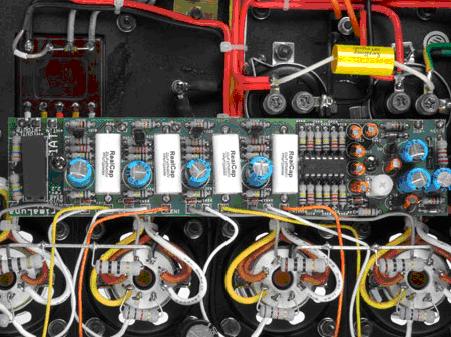The road to nirvana |
|
My journey into Photography, Horology, and Audiophilia |
Prima Luna ProLogue One
March 31, 2009
So, you’ve finally decided to get yourself a tube amplifier to drive your speakers, great! But you’ve read from the discussions in this forum about matched pairs, matched quads, biasing the amplifier, instability of the AC power, which simply freaks you out and causes you to think twice or even thrice. Do I really want that tube amplifier and have to bother with all these?
Good news for you! There is now a push-pull tube amplifier that can put out a mighty 35 watts per channel to drive those 89dB sensitivity (higher or lower depending on how easy are your speakers to drive) speaker of yours with sonic satisfaction, AND do away with all those issues I previously mentioned. What? Are we talking plug-and-play here? You bet we are.
The Prima Luna ProLogue One is an EL34-based, push-pull amplifier with a unique feature that makes owning and operating a tube amplifier both enjoyable and worry-free. We know the sonic virtues of a tube amplifier so that’s given. However, operating them can sometimes prove to be a challenge, especially to those who just want to enjoy the music.
In order to maintain the operating point, hence, maintaining the level of joy of listening, a tube amplifier must maintain its bias. We sometimes pay a premium for getting those matched pair or even matched quads of power tubes only to find out that they wouldn’t last matched for so long. Tubes do not burn evenly, and is more evident with power tubes. This is the reason why we do a “bias check and adjustment” from time to time. A trip to our friendly “tubero” will be necessary if one does not have the skills or patience to do the exercise. Worse, we get home to find out that the bias is now a little bit off, due to the difference in AC voltage between the tubero’s place and ours.
With the ProLogue One’s Adaptive Auto-Bias Board (this is a PCB with lotsa parts), it keeps each of the power tube’s bias on the spot. This intelligent circuit allows you to use non-matched power tubes (if you want to pay the premium for matched, that’s fine but not necessary) and compensates for tube drift as they age. According to the designers, this circuit is also responsible for keeping the distortion down.

The ProLogue One has a small footprint and is cute by my standards. It is heavy though for its size, due to the hefty transformers at the rear end of the unit. Cosmetically, it is a black beauty (at least to my eyes) and I had to wear my cotton gloves to protect the shiny finish from my sweat. The front panel sports the volume control and selector switch with a pair of nice knobs, and an LED to let you know the amp is powered up. You can find the power switch at the left hand side of the unit.

At the back panel, you will find heavy duty speaker binding posts with 4 and 8 ohm taps and four (4) pairs of gold-plated RCA input sockets. The IEC socket makes it easy for you to replace the stock power cord with whatever aftermarket power cord you desire.

So how does it sound? I had to admit I enjoyed it so much driving my Infinity Kappa 200 bookshelf speakers playing head-banging music of the Blue Man Group. This amp can rock! It can rock the way I want it – clean, heavy, composed, and detailed. It did not choke during the percussion attack at around 4:06 on track 5 of the Audio album. The bass slam and depth was excellent and pace can be fast and furious. In comparison, the ProLogue One beats my previous Anthem Amp 1 in this area as the Amp 1 is slower. I give this amp two thumbs up in enjoyment factor when playing this type of music.
On mellower materials such as Radka Tonef/Fairytales, Jacintha/Autum Leaves, and HayleyWestenra/Pure, it exhibited the ability not to be boring and putting me to sleep. Although I would prefer Hayley Westenra’s voice to be a little sweeter, it did not prevent me from being mesmerized by her voice in Who Painted the Moon Black.
The ProLogue One exhibited excellent high frequency extension without becoming edgy when pushed hard, couple that with its ability to control the bottom end. I believe that soundstaging and imaging are factors that are much more speaker dependent, but the ProLogue One did not disappoint in this area. With proper speaker placement, this amp can create a wide and deep soundstage.
In my short experience with this amp I noticed that you should let the auto-bias circuit do its work for a few minutes. In my initial listening upon power on, it seems not to have the low end extension I am expecting, but after a while it gets up to speed.
As an integrated amplifier, it has plenty of gain. The input sensitivity is around 300mV and can be driven to very loud SPL from a CD player given that your speakers are not that hard to drive (my Infinity Kappa is an easy drive).
I described the sonic qualities of the amp with the stock tubes, which I cannot identify due to the tube cage, installed. You could probably do tube rolling but why fix something that is not broken?
The ProLogue One is looking for a new home, and this is something easily adopted and well-loved.
Software
- Radka Tonef/Fairytales
- Jacintha/Autumn Leaves
- Hayley Westenra/Pure
- Blue Man Group/Audio
- Blue Man Group/The Complex
Associated Gear
- Harman Kardon HD-750 HDCD player
- Infinity Kappa 200 speakers
- Eichmann Cables Express 6 interconnect
- John Risch DIY CAT-5 speaker cable